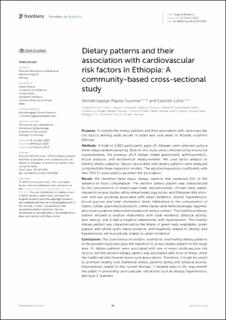Dietary patterns and their association with cardiovascular risk factors in Ethiopia: A community-based cross-sectional study
Journal article, Peer reviewed
Permanent lenke
https://hdl.handle.net/11250/3060228Utgivelsesdato
2023-03-01Metadata
Vis full innførselSamlinger
- Publications [1488]
Sammendrag
Purpose: To identify the dietary patterns, and their association with cardiovascular risk factors among adult people in Wolaita, southern Ethiopia. Methods: A total of 2483 participants aged 25-64 years were selected using a three-stage random sampling. Data for this study were collected using structured questionnaires, the previous 24-hour dietary intake assessment, anthropometric, blood pressure, and biochemical measurements. We used factor analysis to identify dietary patterns. Factors associated with dietary patterns were analyzed using multiple linear regression models. The adjusted regression coefficients with their 95% CI were used to ascertain the association. Result: We identified three major dietary patterns that explained 51% of the variance in food consumption. The western dietary pattern was characterized by the consumption of meat/organ meat, biscuits/sweets, chicken stew, pasta-macaroni recipes, butter, white wheat bread, egg recipe, and Ethiopian dish shiro-wet, and was positively associated with urban residence, obesity, hypertension, blood glucose, and total cholesterol levels. Adherence to the consumption of tubers, whole-grain maize products, coffee leaves-and-herbs beverage, legumes, and sweet potatoes featured the traditional dietary pattern. The traditional dietary pattern showed a positive relationship with rural residence, physical activity, and obesity, and it had a negative relationship with hypertension. The healthy dietary pattern was characterized by the intake of green leafy vegetables, green pepper, and whole-grain maize products, and negatively related to obesity, and hypertension, while positively related to urban residence. Conclusions: The coexistence of western, traditional, and healthy dietary patterns in the present study indicates the transition to a new dietary pattern in the study area. All dietary patterns were associated with one or more cardiovascular risk factors, but the western dietary pattern was associated
